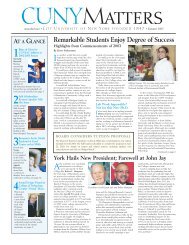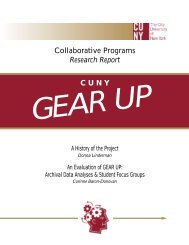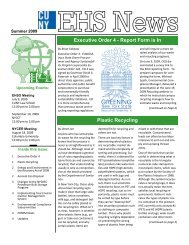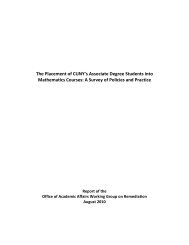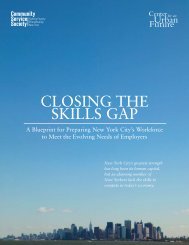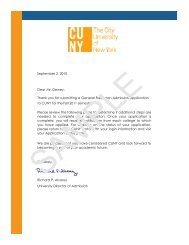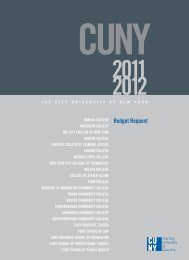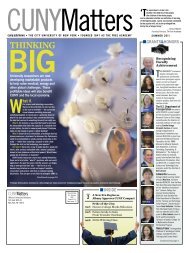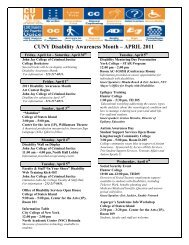CUNY Master Plan 2012-2016
CUNY Master Plan 2012-2016
CUNY Master Plan 2012-2016
You also want an ePaper? Increase the reach of your titles
YUMPU automatically turns print PDFs into web optimized ePapers that Google loves.
THE <strong>CUNY</strong> MASTER PLAN <strong>2012</strong>-<strong>2016</strong><br />
Queensborough, and roof replacement and bathroom upgrades at Hostos. These efforts will continue as<br />
projects are completed and new issues arise.<br />
The third initiative involves financing and developing new <strong>CUNY</strong> facilities through public/private<br />
partnerships.<br />
• Residence Halls: In 2006, <strong>CUNY</strong> opened its first public/private residence hall on the City College<br />
campus. In fall 2011 the Towers at City, a 589-bed residence hall, was 91 percent occupied. In 2009,<br />
Queens College opened the Summit, a 506-bed residence hall on campus, which had a fall 2011 occupancy<br />
rate of 98 percent. The Graduate Center Apartments, offering bright, modern, airy, and affordable<br />
housing for graduate students, postdoctoral fellows, and members of the faculty opened in fall<br />
2011 (100 percent occupancy). Additionally, the College of Staten Island has a 454-bed residence hall<br />
designed and ready for financing in early <strong>2012</strong>. The University is exploring opportunities for the<br />
Manhattan colleges to occupy a shared facility.<br />
• Silberman School of Social Work at Hunter College and the <strong>CUNY</strong> School of Public Health at<br />
Hunter College: Opened in fall 2011, the Silberman School of Social Work at Hunter College and the<br />
<strong>CUNY</strong> School of Public Health at Hunter College involved the purchase of a property in East Harlem<br />
in order to relocate the Silberman School from its current leased facility on Manhattan’s Upper East<br />
Side. A new 147,000-square-foot building was constructed on the purchased land to provide the<br />
school with a permanent, owned facility. This public/private partnership was made possible through<br />
the sale of the leased facility on East 79th Street, including the school’s lease interest at that site, to a<br />
developer who was required to build the new facility in East Harlem before taking possession of the<br />
79th Street building.<br />
• New York Simulation Center for Health Sciences:<br />
Also opened in fall 2011, the New York Simulation<br />
Center for Health Sciences is a joint venture<br />
between <strong>CUNY</strong> and New York University (NYU)<br />
Langone Medical Center. The Simulation Center,<br />
located on a floor at Bellevue Hospital, is the largest<br />
state-of-the-art training facility for first responders,<br />
emergency response workers, health care students,<br />
and professionals in the nation. <strong>CUNY</strong> provided the<br />
capital dollars for the renovation of the space, and<br />
NYU will provide an equivalent amount in operating<br />
funds, anticipated to cover the first decade of operations.<br />
Funding for this project was made available<br />
through Assembly Speaker Sheldon Silver, who saw<br />
the need for a training center following 9/11; he<br />
appropriated $10.5 million in the state budget, which<br />
was matched by Mayor Bloomberg in the city budget.<br />
New York Simulation Center for<br />
Health Sciences<br />
92





